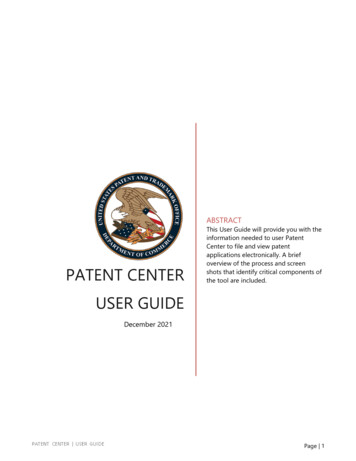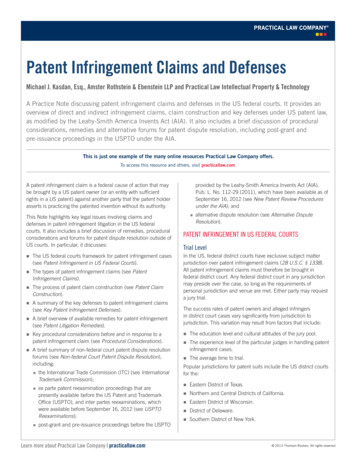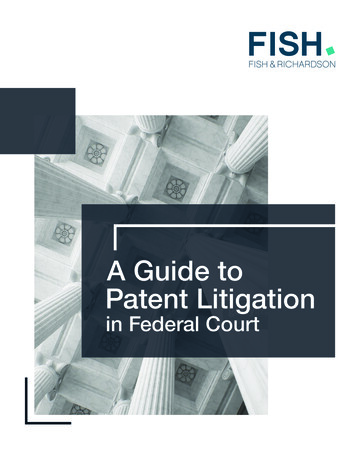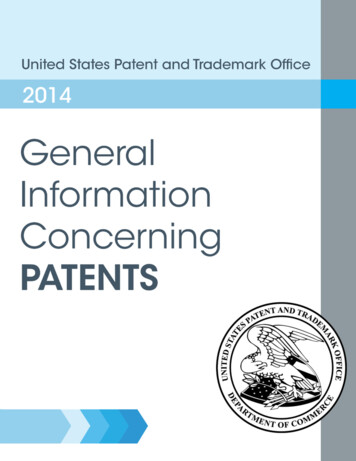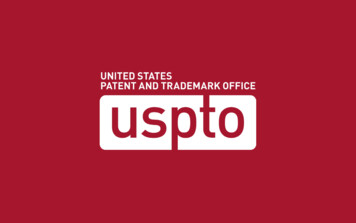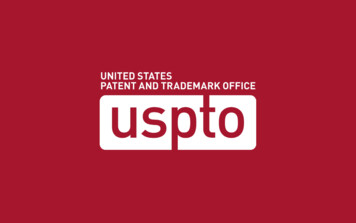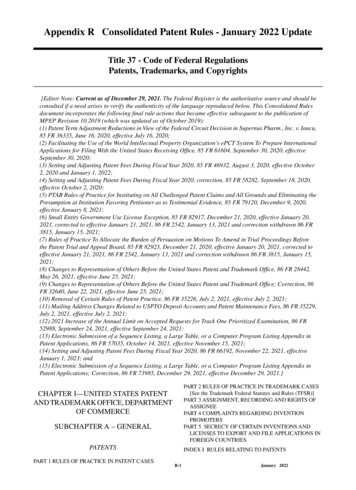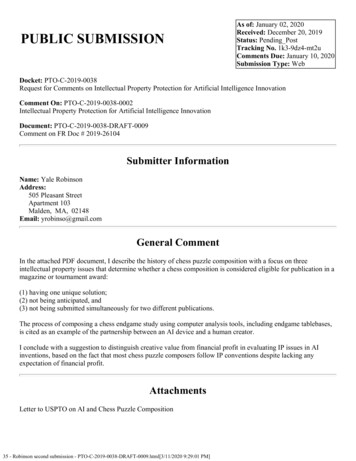
Transcription
PUBLIC SUBMISSIONAs of: January 02, 2020Received: December 20, 2019Status: Pending PostTracking No. 1k3-9dz4-mt2uComments Due: January 10, 2020Submission Type: WebDocket: PTO-C-2019-0038Request for Comments on Intellectual Property Protection for Artificial Intelligence InnovationComment On: PTO-C-2019-0038-0002Intellectual Property Protection for Artificial Intelligence InnovationDocument: PTO-C-2019-0038-DRAFT-0009Comment on FR Doc # 2019-26104Submitter InformationName: Yale RobinsonAddress:505 Pleasant StreetApartment 103Malden,MA,02148Email: yrobinso@gmail.comGeneral CommentIn the attached PDF document, I describe the history of chess puzzle composition with a focus on threeintellectual property issues that determine whether a chess composition is considered eligible for publication in amagazine or tournament award:(1) having one unique solution;(2) not being anticipated, and(3) not being submitted simultaneously for two different publications.The process of composing a chess endgame study using computer analysis tools, including endgame tablebases,is cited as an example of the partnership between an AI device and a human creator.I conclude with a suggestion to distinguish creative value from financial profit in evaluating IP issues in AIinventions, based on the fact that most chess puzzle composers follow IP conventions despite lacking anyexpectation of financial profit.AttachmentsLetter to USPTO on AI and Chess Puzzle Composition35 - Robinson second submission - PTO-C-2019-0038-DRAFT-0009.html[3/11/2020 9:29:01 PM]
December 20, 2019From: Yale Yechiel N. Robinson, Esq.505 Pleasant Street #103Malden, MA 02148Email: yrobinso@gmail.comTo:Andrei IancuDirector of the U.S. Patent and Trademark Office (USPTO)P.O. Box 1450Alexandria, VA 22313-1450Email: AIPartnership@uspto.govRe:Request for Comments on Intellectual Property Protection for Artificial IntelligenceInnovation1Docket number: PTO-C-2019-0038Dear Mr. Iancu:IntroductionThe USPTO’s Request for Comment concludes with question number 13, which is relevant tothe norms of chess puzzle composition in the era of computer chess and endgame tablebases:13. Are there any relevant policies or practices from intellectual propertyagencies or legal systems in other countries that may help inform USPTO’spolicies and practices regarding intellectual property rights (other than thoserelated to patent rights)?I respectfully suggest that chess puzzle composition is particularly well suited to provide ananalytical framework precisely because money does not drive innovation in this field. Mostchess composers (including me) have spent dozens of hours composing and solving puzzles as ahobby, where the reward of seeing one’s name alongside a chess diagram in a foreign languagepublication somehow justifies the pursuit of creativity in this quirky domain as an alternative topainting, music, or other creative arts.OverviewI describe the history of chess puzzle composition with a focus on three intellectual propertyissues that determine whether a chess composition is considered eligible for publication in amagazine or tournament award:1The author submits the present document by PDF file upload using the “Comment Now” button at the followinghyperlink: https://www.regulations.gov/document?D PTO-C-2019-0038-0002The author emailed a previous version of this document to AIPartnership@uspto.gov on December 16, 2019.
Comment by Yale Yechiel N. Robinson, Esq.Request for Comment on Intellectual Property Protection for Artificial Intelligence InnovationDocket number: PTO-C-2019-0038December 20, 2019Page 2(1) Having one unique solution;(2) Not being anticipated, and(3) Not being submitted simultaneously for two different publications.The process of composing a chess endgame study using computer analysis tools, includingendgame tablebases, is cited as an example of the partnership between an AI device and a humancreator.I conclude with a suggestion to distinguish creative value from financial profit in evaluating IPissues in AI inventions, based on the fact that most chess puzzle composers follow IPconventions despite lacking any expectation of financial profit.Historical Background of Computer Chess and Endgame TablebasesIn addition to my professional work as a Patent Attorney and in other legal matters, I have foryears enjoyed the intergenerational conversation within the game of chess, which originatedmany centuries ago and spread across Europe and North America around the middle of the 19thcentury, and has since reached every major country in the world.I will direct my comments regarding issues of intellectual property for artificial intelligenceinnovations based on the history of traditional western chess. Early innovators in computing,including Alan Turing and Claude Shannon, tried to calculate the value of certain chess positionsusing the 1950-era equivalent of a present-day handheld calculator. Their work launched the ageof computer chess, where the strongest present-day computers can consistently (but not always)defeat or draw elite human grandmasters. The quality of human-versus-human play hasincreased in part because of computer analysis of opening and middle-game positions that strongplayers can analyze and practice playing on their home computer device before trying the ideaagainst a human player in competition.In addition to the development of chess theory for the benefit of chess players (human andelectronic alike), the impact of chess computing has arguably extended beyond the limits of thegame itself. Chess computing has been considered a test module for the ability of artificialintelligence software to make decisions in a situation where the theoretical value of a position isontologically determinable, but the complexity of the search space prevents a solver of limitedcapability from determining the theoretical value and, therefore, the fallible player cannot findthe best move to play on the chessboard in order to preserve the ideal theoretical value.An interesting development in the search for ultimate truth in the chess context is the publicationonline of freely searchable endgame tablebases, where the term “tablebase” apparentlydeveloped as a compromise among chess computing experts in the 1980s who referred to theconcept alternatively as “endgame table” or “endgame database.” Examples of pioneers in thefield include the following researchers, who each hold a Ph.D. in a related field:
Comment by Yale Yechiel N. Robinson, Esq.Request for Comment on Intellectual Property Protection for Artificial Intelligence InnovationDocket number: PTO-C-2019-0038December 20, 2019 Lewis Stiller,2 Guy Haworth,3 Azlan Iqbal,4 and Harold van der Heijden.5Page 3The key difference between an endgame tablebase and a traditional chess computing program isthe direction and timing of the analysis. In a traditional chess computer program of the typepioneered by Turing and Shannon, algorithms such as alpha-beta and minimax are used toestimate the best move in a complex position by searching a limited number of moves from thecurrent position on the chessboard into a hypothetical set of future positions that may occurseveral moves later. This forward search in real time is limited by the fact that it is usually notpossible to analyze a complex position all the way to an ending position of checkmate or adetermination that checkmate will never occur and the game will become a draw.In contrast, an endgame tablebase is created by compiling the entire group of all theoreticallypossible positions with a given set of material, then identifying all positions in which the losingplayer has been checkmated. Working backwards, the next earlier move in a perfectly playedgame between two omniscient players would involve the losing player making his last movebefore the opponent will checkmate him. Working backwards further, a series of moves by bothplayers can be discovered, in which checkmate can be foreseen ten or even one hundred movesbefore the checkmate will actually occur with perfect play.6 Some positions are excluded fromthe retrograde analysis tree of positions that will eventually lead to checkmate; instead, thoseunclassified positions are considered draws because neither player can force checkmate.I have used endgame tablebases in the hobby of composing endgame study puzzles forpublication in quarterly periodical magazines such as The Problemist (UK), Variantim (Israel),and StrateGems (USA).2See, for example: “Multiliner Algebra and Chess Endgames” by Lewis Stiller. Games of No Chance, iller.pdf3Haworth, G. (2017) “Chess endgame news.” ICGA Journal, 39 (2). p. 172. ISSN 13896911 Available at http://centaur.reading.ac.uk/72281/4“A Computer Composes A Fabled Problem: Four Knights vs. Queen” by Azlan Iqbal 9.00931.pdf5Dr. Heijden has compiled a database of all endgame study puzzles that have been published in major chessperiodicals during the last two hundred years approximately. The current 5 th version of his database is available forpurchase and download. It has been used to assist in composition and analysis of newly discovered chess positions.See: Harold van der Heijden Endgame Study Database V, available at: http://hhdbv.nl/6A forcing checkmate sequence lasting 549 moves was found in a 7-piece endgame tablebase. See Tim Krabbé,Open Chess Diary, Item 393: https://timkr.home.xs4all.nl/chess2/diary.htm
Comment by Yale Yechiel N. Robinson, Esq.Request for Comment on Intellectual Property Protection for Artificial Intelligence InnovationDocket number: PTO-C-2019-0038December 20, 2019Page 4Intellectual Property (IP) Issues in Chess Puzzle CompositionEven though chess composers do not work for pay, and are fully aware of that fact beforeundertaking an attempt at composing a work of mathematical art, there is still a framework ofinformal rules and standards for publication that the chess problem magazines enforce in order toassure that readers will receive high quality puzzles to justify the cost of the readers’ annualsubscriptions. In the words of The Cat in the Hat, as composed by Dr. Seuss: “It is fun to havefun, but you have to know how!”A publishable chess endgame study must require the solver, who is usually given the white chesspieces in a hypothetical chess position, to attain a best-case outcome of either a win (“White toplay and win”) or draw (“White to play and draw”). The prompt to “win” or “draw” is similar toa player’s goal in an actual chess game—either to win or to draw the game, regardless of howlong it may take to achieve the desired result. Thus, endgame studies are distinguishable fromtime-limited problems, where n 2: Directmates: “White to play and checkmate Black in n moves.” Selfmates: “White to play and force Black to checkmate White in n moves.” Helpmates: Both players cooperate to cause Black to be checkmated in n moves.Chess endgame studies share aspects of both patent and copyright theory. In terms of patenttheory, a chess endgame study must possess both accuracy and novelty. Accuracy means that the puzzle has one unique meaningful solution, although a trivialduality in a side variation is tolerated as long as the intended main-line solution is unique. Novelty means that the position has not been published in a prior publication. Althoughobviousness in patent law does not necessarily correlate to anticipation in chess puzzlecomposition, a publisher may reject a chess puzzle submission from appearing in print ifthe main-line solution has been published elsewhere, even if some side variations orintroductory moves are newly composed.A chess puzzle that lacks accuracy is considered “cooked” either because the original intendedsolution does not accomplish the intended goal or, conversely, because an unexpected secondline of play renders the intended solution non-unique. A “cooked” composition resembles aninoperable device that would fail to satisfy the utility requirement of 35 U.S.C. § 101.Similarly, a chess puzzle that has been published by another author is considered“anticipated”—the same term commonly used to reject patent applications for failure to satisfythe novelty criteria of 35 U.S.C. § 102.
Comment by Yale Yechiel N. Robinson, Esq.Request for Comment on Intellectual Property Protection for Artificial Intelligence InnovationDocket number: PTO-C-2019-0038December 20, 2019Page 5In terms of copyright theory, it is considered in poor taste to submit a chess composition tomultiple simultaneous tournaments or magazine publishers without first notifying each potentialpublisher of the duplicate submission. Just as a chess puzzle may be anticipated by a priorpublication by another author, it may also be inappropriate because of a prior or simultaneouspublication by the same author.I have had personal experience with each of the issues identified above: “cooked” solutions,anticipation, and simultaneous publication.“Cooked” Invalid SolutionsMore than ten years ago, I submitted a chess composition to Grandmaster Dr. John Nunn for acomposing tourney in honor of his birthday that year. Dr. Nunn kindly pointed out to me byemail that my submission was incorrect because of a second solution that I had not noticed in myown analysis at home.Subsequently, I made sure to run my chess puzzles through an endgame tablebase if possible,7 oralternatively through a traditional alpha-beta analysis program such as Stockfish, which can bequeried for free on the Internet.8AnticipationA fully anticipated study fails the requirement of originality that publishers demand from chessproblem composers. However, a new twist on an old idea is sometimes acceptable forpublication. An amusing example of improving on a classical work of art came to me when Ireviewed a well-known simple study published by Jan Marwitz in 1937, as explained below byIrving Chernev in his book Practical Chess Endings (New York, copyright 1961):9Mr. Chernev describes chess moves on the next page using English descriptive notation.10 Later,the Italian publication of my solution to the study on page 7 below is explained using Italianalgebraic notation.117The be strongest current set of chess tablebases covers all positions with 7 or fewer chess pieces for both playerscombined (for example, White has four pieces, and Black has three other pieces). Any Internet user can input anychess position with 7 or fewer pieces to look up the theoretical result with best play according to the data stored inthe Syzygy Tablebases, available at: https://syzygy-tables.info/8Stockfish chess engine website: https://stockfishchess.org/9The image above of page 98 of Chernev’s Practical Chess Endings is copied from the following website:https://indianchess.org/yahoo site �Descriptive Notation” article on Wikipedia (December 20, 2019):https://en.wikipedia.org/wiki/Descriptive notation11“Algebraic Notation (Chess)” article on Wikipedia (December 20, 2019):https://en.wikipedia.org/wiki/Algebraic notation (chess)
Comment by Yale Yechiel N. Robinson, Esq.Request for Comment on Intellectual Property Protection for Artificial Intelligence InnovationDocket number: PTO-C-2019-0038December 20, 2019Working backwards from the Marwitz position shown above, I discovered a position whereWhite could sacrifice a knight and a bishop in order to arrive at the Marwitz position.Page 6
Comment by Yale Yechiel N. Robinson, Esq.Request for Comment on Intellectual Property Protection for Artificial Intelligence InnovationDocket number: PTO-C-2019-0038December 20, 2019Page 7An Italian chess magazine accepted my request to publish the variant study above in SinfonieScacchistiche (January – March 2016). The position at the bottom of the preceding page iscopied from page 13 of the Italian magazine, and the solution below is copied from page21.Simultaneous PublicationFinally, as to simultaneous publication in two different magazines, I fell afoul of this norm aboutthree years ago when I submitted two similar or identical endgame studies featuring the motif oftwo white knights preventing a black rook from escaping a restricted area on the back rank of thechessboard. A friend in Europe emailed me to express gently his displeasure at the fact that Ihad submitted to him a study that duplicated my previous study published elsewhere.Apparently the duplication escaped his notice until after his magazine had already published mystudy. The friend invited me to withdraw my study from eligibility to receive an honorary awardat the end of the year. This was effectively a symbolic gesture because my study probably wouldnot have qualified for an award in deference to studies by other composers. Furthermore, anyaward would have been only for honor but not money.However, if the purpose of engaging in a creative hobby is to make friends and enjoyconversations with people across the world that I might not otherwise encounter, I learned thelesson to follow the good graces of what those people desire in a relationship.
Comment by Yale Yechiel N. Robinson, Esq.Request for Comment on Intellectual Property Protection for Artificial Intelligence InnovationDocket number: PTO-C-2019-0038December 20, 2019Page 8Successful Integration of Artificial Intelligence with Human CreativityAfter 6-piece tablebases became available online for free access around 2005, followed by 7piece tablebases around 2015, I searched these tablebases for interesting positions and ideas. Ipublished a few pf these positions as endgame studies in magazines and tournaments.My search process consisted entirely of trial and error by hand. However, Mr. Arpad Rusz andsome other endgame study composers have used artificial intelligence software to search forinteresting positions in the tablebase data set.12My personal view is that the endgame studies that Mr. Rusz discovered using his software holdequal validity as if he discovered these positions by trial and error. If the purpose of publishingchess puzzles is to arouse the intellectual curiosity of composers and solvers, the path to findingan interesting chess position makes little difference to me. Furthermore, some of mycompositions were aided by the fact that I already knew from the tablebase that a certain positionhas a unique best move. It was not necessary for me to undertake the human analysis that 20thcentury composers had to attempt before publishing studies in the pre-tablebase era.Referring back to my modification of the Marwitz study, I used a printed publication to start thethought process of working backwards and finding three introductory moves that would enhancethe pleasure of a hypothetical solver who would read the magazine. Then, I used an endgametablebase to confirm that my 6-pice ending was consistent with the requirement that a study musthold one unique solution. You can play through the solution of my version of the study (whichleads to the Marwitz position after the first three moves) by clicking on the hyperlink in thefootnote for the interactive tablebase web application.13Despite using both a previously published study for inspiration and a tablebase to confirmtechnical accuracy, I believe—and the publisher, Mr. Valerio Agostini, agreed—that myadaptation of the Marwitz study would enhance the experience of at least a few readers andsolvers. It was a creative work of art, regardless of the assistance I received from the originalcomposer Jan Marwitz, the commentator Irving Chernev, the tablebase program and its softwareprogrammers, and Mr. Agostini.Distinguishing Creative Value from Financial ProfitI respectfully suggest the USPTO should try, where possible, to bifurcate the questions of “is thiswork a product of human creativity” and the ancillary question of “who has financial propertyrights to it.”12Arpad Rusz, “Syzygy Endgame Explorer (SEE)” blog post: yendgame-explorer-see.html13Syzygy Tablebase web application, showing the starting position of my adaptation of the Marwitz endgame study:https://syzygy-tables.info/?fen 4B3/8/8/N2kP3/8/6K1/8/2n5 w - - 0 1
Comment by Yale Yechiel N. Robinson, Esq.Request for Comment on Intellectual Property Protection for Artificial Intelligence InnovationDocket number: PTO-C-2019-0038December 20, 2019Page 9Chess composition allows us to consider the first question without being blinded by the secondquestion. I use the word “blinded” by analogy with the Biblical teaching that bribery blinds the eyes of awise judge and can lead to a perversion of justice.14 Clearly, the complexity of intellectual propertydisputes prevents a broad characterization of any particular view as bribery. However, a clear-eyedanalysis of what constitutes property should begin with a conceptual framework that does not relyexclusively on whether an item holds a large quantity of financial value.If, hypothetically, my adaptation of the Marwitz endgame study were to hold financial value, itmight be necessary to assign some formula to distribute profits to the Italian magazine, the estateof Jan Marwitz, the tablebase software developer, and to me. Thankfully, we don’t need toconsider that question.I could not have composed the sequential sacrifice of a knight followed by a bishop withoutsome help from predecessors and contemporaries. But similarly, I could not have composed thepresent document without access to a computer with an Internet connection that enabled me todownload and copy images from certain websites. I wonder: is there really any differencebetween using the Internet for research and writing, versus using artificial intelligence to help ahuman composer evaluate whether his work is publishable?I am not advocating for or against any particular policy. I started typing on a blank computerscreen without a clear idea or agenda, and I remain in an unresolved state of mind. However, Ithink it may be helpful to consider the questions of creative value and financial profit asdistinctly as possible.AcknowledgmentI acknowledge the encouragement of Robert W. Bahr, Deputy Commissioner for PatentExamination Policy at the USPTO, who visited Boston and kindly spoke with me an educationalseminar sponsored by the American Intellectual Property Law Association (AIPLA) and in partby the Boston Patent Law Association (BPLA) on December 10, 2019.Mr. Bahr responded favorably to my offer to write about chess composition as an alternativeform of intellectual property where artificial intelligence plays a role. I hope that CommissionerIancu, Deputy Commissioner Bahr, and fellow members of the professional IP community willfind the preceding comments helpful.Sincerely,Yale Yechiel N. Robinson, Esq.14Exodus 23:8; Deuteronomy 16:19.
35 - Robinson second submission - PTO-C-2019-0038-DRAFT-0009.html[3/11/2020 9:29:01 PM] PUBLIC SUBMISSION As of: January 02, 2020 Received: December 20, 2019 Status: Pending_Post Tracking No. 1k3-9dz4-mt2u Comments Due: January 10, 2020 Submission Type: Web Docket: PTO-C-2019-0038 Request for Comments on Intellectual Property Protection for Artificial Intelligence Innovation
